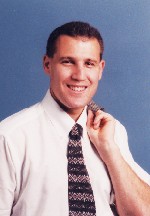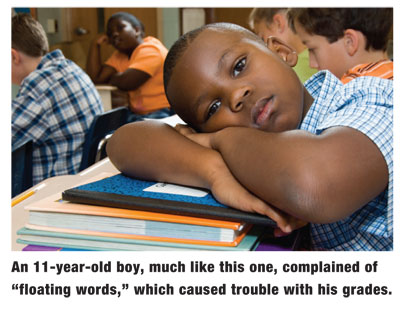
History
An 11-year-old black male presented complaining of floating words that were most noticeable while reading. He also complained of occasional diplopia at near, which he described as worsening since the new school year started. His mother indicated that his performance had been dropping in school as well.
The patient had no history of childhood illness or trauma, no history of ocular or systemic disease, and no history of allergies. He was not taking any medication.

Diagnostic Data
His uncorrected acuity measured 20/20 at distance and near in each eye. His uncorrected cover test revealed 12 prism diopters (PD) exophoria at near and 5PD exophoria at distance.
Confrontation fields were full O.U., and pupils were normal with no afferent pupillary defect. Stereopsis revealed normal depth perception with both contour and random dot targets. Versions were full and smooth.
Refraction yielded +0.75D O.D. and +0.75 -0.50 x 180 O.S. Corrected cover test revealed 14PD exophoria in primary gaze at near. Base-in ranges at near were 12/19/13 (blur/break/recovery), while base-out ranges were 4/6/5. Accommodative amplitudes were normal. The accommodative convergence/accommodation (AC/A) ratio was calculated at 2/1.
Biomicroscopy revealed normal anterior segment structures O.U. Intraocular pressure measured at 19mm Hg in both eyes.
The dilated fundus examination was unremarkable. Cup-to-disc ratios were 0.25 x 0.25 O.U., and there were no peripheral pathologies.
Your Diagnosis
How would you approach this case? Does this patient require additional tests? What is your diagnosis? How would you manage this patient? What is the likely prognosis?
Thanks to Josephine Ibironke, O.D., of the Wilmer Eye Institute,
Discussion
Additional tests might include a wet refraction to check for latent hyperopia and autorefraction to obtain another objective measurement. This patient also underwent additional binocular vision tests, namely:
Near point of convergence, which demonstrated a 10cm break/15cm recovery.
Vergence facility, which demonstrated 0 cycles per minute (cpm) and failure of base-out.
Binocular and monocular accommodative facility (BAF/MAF). BAF demonstrated 0cpm with failure to clear plus. MAF demonstrated 10cpm in each eye.
Negative and positive relative accommodation (NRA/PRA), which demonstrated +1.00/-2.50.
The diagnosis in this case is convergence insufficiency (CI). We explained to the patients mother that CI is a common binocular vision anomaly that could cause significant symptoms during reading and near-point tasks and consequently, could affect his grades.1
The prevalence of CI among adults and children may be between 2.25% to 8.30%.1,2 The anomaly is characterized by exophoria that is greater at near with a receded near-point of convergence, low AC/A ratio and reduced positive fusional vergence.1,3
Management options include vision therapy (office- and home-based), base-in prism to alleviate symptoms and surgery in severe cases.1,3 The use of base-in prism is a passive treatment, though, because of its compensatory nature.2 Pencil pushups are commonly prescribed, but recent studies have shown that office-based vision therapy is more effective.2
Lenses or prisms were not necessary in this case. This patient instead began a 15-week office- and home-based vision therapy regimen. It included computer activities and other exercises, which introduced smooth and jump fusional vergence procedures (to improve his ability to converge and diverge) and accommodative procedures (to increase accommodation and his response). Specific procedures used during the therapy included Brock string activities, lens sorting, loose lens rock, vectograms (with and without loose prisms), barrel cards activities, aperture rule activities, eccentric circles and computer activities.
The patient was very compliant and motivated. His prognosis is good.
1. Gallaway M, Scheiman M, Malhotra K. The effectiveness of pencil pushups treatment for convergence insufficiency: a pilot study. Optom Vis Sci 2002 Apr;79(4):265-7.
2. Scheiman M, Mitchell GL, Cotter S, et al. Convergence Insufficiency Treatment Trial Study Group. A randomized clinical trial of treatments for convergence insufficiency in children. Arch Ophthalmol 2005 Jan;123(1):14-24.
3. Scheiman M, Wick B. Clinical Management of Binocular Vision: Heterophoric, Accommodative, and Eye Movement Disorders.

